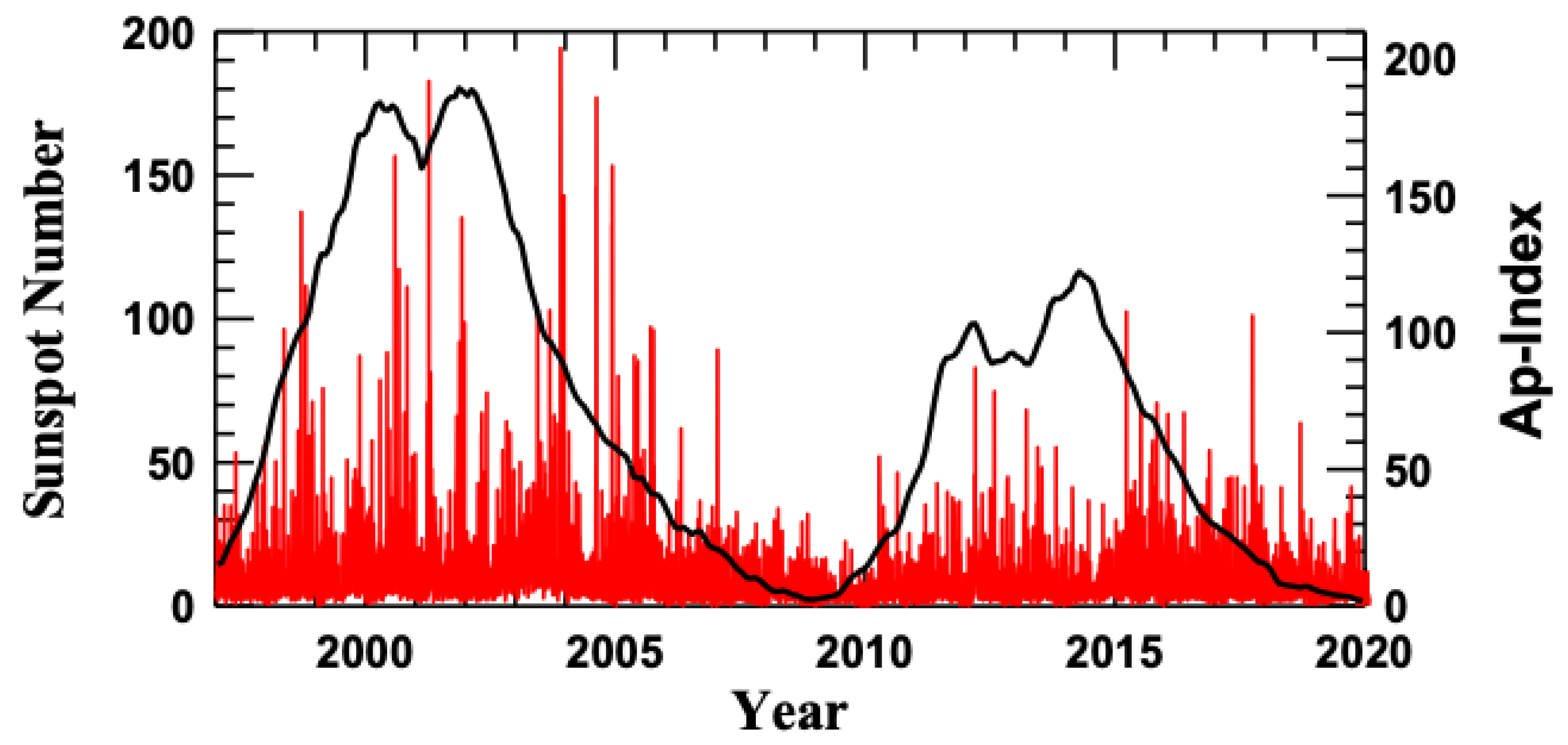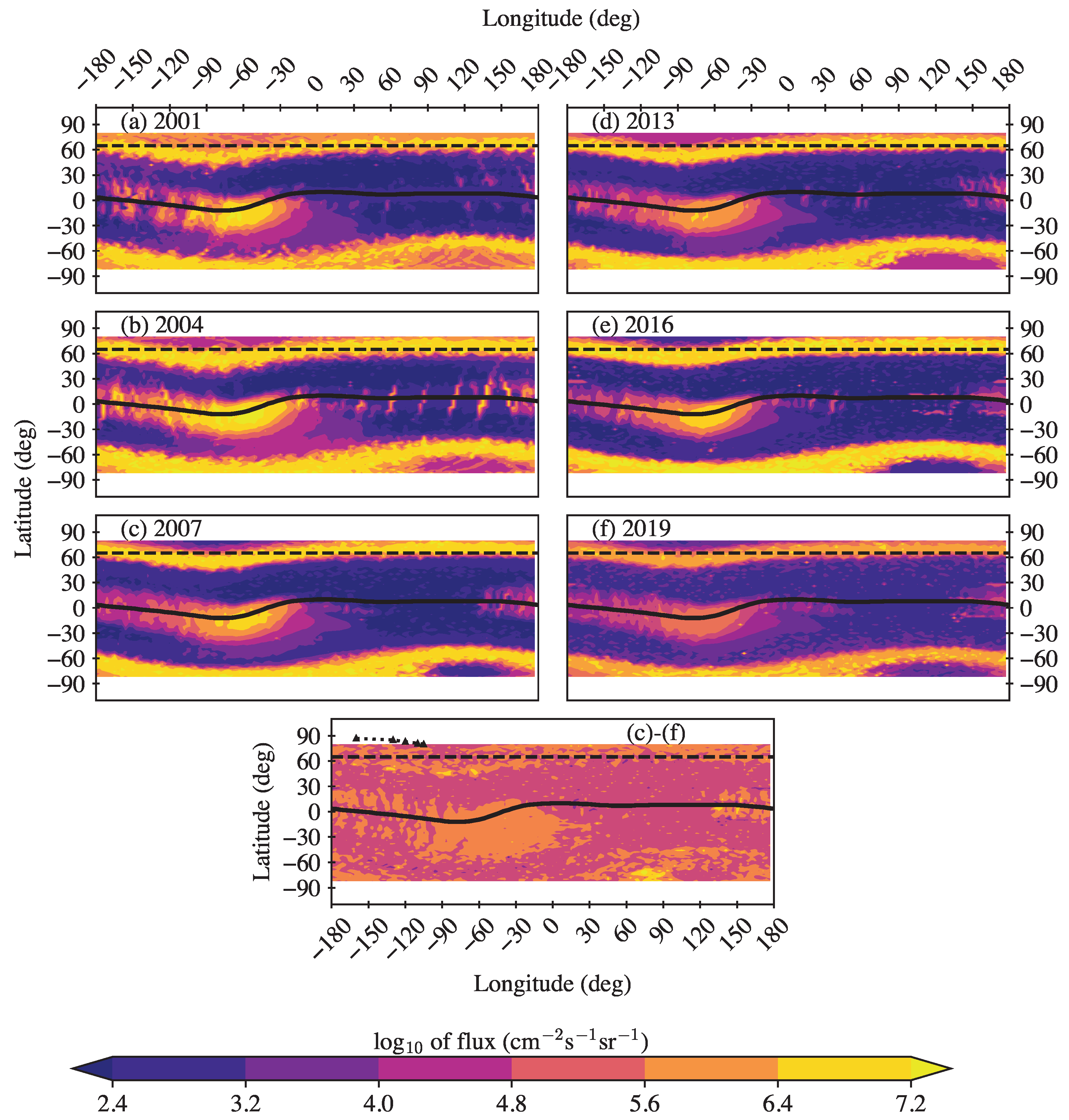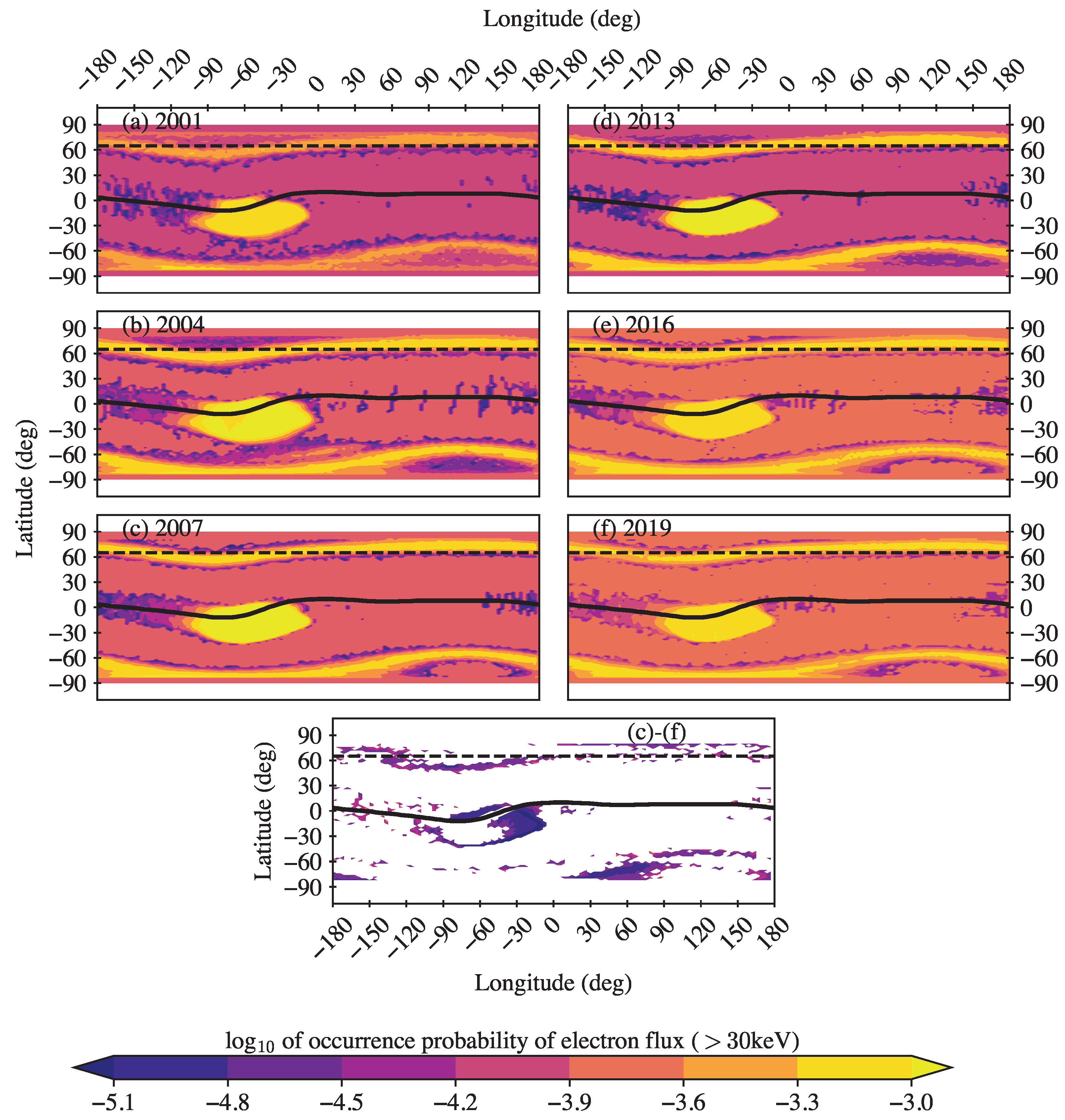Spatial Evolution of Energetic Electrons Affecting the Upper Atmosphere during the Last Two Solar Cycles
Abstract
1. Introduction
2. Experimental Data
3. Results
4. Discussion
5. Conclusions
- The area of electron precipitation from the outer ERB shifted over eastern longitudes (Siberia) toward the equator. This is in good agreement with the latest data on the dynamics of the geomagnetic North Pole.
- The intensity of energetic electron fluxes in the SAA region, as well as its area, significantly decreased in the 24th solar cycle compared to the 23rd cycle. This was caused mainly by prominent changes in the geomagnetic field at low latitudes such that the magnetic field strength increased in the SAA region, which resulted in elevation of the inner ERB.
- The distribution of quasi-trapped electrons obtained in this work at low latitudes makes it possible to confirm the mechanism of their appearance under the inner ERB zone at an altitude of 850 km due to anomalous earthward radial transport from the inner ERB zone. The latter is especially important to take into account in order to increase the stability of the operation of global navigation satellite systems and remote sensing of the Earth [23,24,25].
- In order to separate the effects of geomagnetic activity and the geomagnetic field changes in the electron ERB dynamics, we plan additional sophisticated analyses with more data in the near future.
Author Contributions
Funding
Institutional Review Board Statement
Informed Consent Statement
Data Availability Statement
Acknowledgments
Conflicts of Interest
References
- Golubkov, G.V.; Dmitriev, A.V.; Suvorova, A.V.; Golubkov, M.G. Variations of Energetic Electron Fluxes in the Ionosphere during Periods of Solar Cycles. Russ. J. Phys. Chem. B 2019, 13, 874–883. [Google Scholar] [CrossRef]
- Dmitriev, A.V.; Jayachandran, P.T.; Tsai, L.C. Elliptical model of cutoff boundaries for the solar energetic particles measured by POES satellites in December 2006. J. Geophys. Res. Sp. Phys. 2010, 115, A12244. [Google Scholar] [CrossRef]
- Rees, M.H. Auroral ionization and excitation by incident energetic electrons. Planet. Space Sci. 1963, 11, 1209–1218. [Google Scholar] [CrossRef]
- Verkhoglyadova, O.P.; Tsurutani, B.T.; Mannucci, A.J.; Mlynczak, M.G.; Hunt, L.A.; Komjathy, A.; Runge, T. Ionospheric VTEC and thermospheric infrared emission dynamics during corotating interaction region and high-speed stream intervals at solar minimum: 25 March to 26 April 2008. J. Geophys. Res. Sp. Phys. 2011, 116, A09325. [Google Scholar] [CrossRef]
- Baker, D.N.; Jaynes, A.N.; Hoxie, V.C.; Thorne, R.M.; Foster, J.C.; Li, X.; Fennell, J.F.; Wygant, J.R.; Kanekal, S.G.; Erickson, P.J.; et al. An impenetrable barrier to ultrarelativistic electrons in the Van Allen radiation belts. Nature 2014, 515, 531–534. [Google Scholar] [CrossRef]
- Panasyuk, M.I.; Podzolko, M.V.; Kovtyukh, A.S.; Brilkov, I.A.; Vlasova, N.A.; Kalegaev, V.V.; Osedlo, V.I.; Tulupov, V.I.; Yashin, I.V. Optimization of measurements of the Earth’s radiation belt particle fluxes. Cosm. Res. 2017, 55, 79–87. [Google Scholar] [CrossRef]
- Dmitriev, A.V.; Suvorova, A.V.; Klimenko, M.V.; Klimenko, V.V.; Ratovsky, K.G.; Rakhmatulin, R.A.; Parkhomov, V.A. Predictable and unpredictable ionospheric disturbances during St. Patrick’s Day magnetic storms of 2013 and 2015 and on 8–9 March 2008. J. Geophys. Res. Sp. Phys. 2017, 122, 2398–2423. [Google Scholar] [CrossRef]
- Liu, J.; Angelopoulos, V.; Frey, H.; McFadden, J.; Larson, D.; Glassmeier, K.; Mende, S.; Russell, C.T.; Rae, I.J.; Murphy, K.R.; et al. THEMIS observation of a substorm event on 04:35, 22 February 2008. Ann. Geophys. 2009, 27, 1831–1841. [Google Scholar] [CrossRef][Green Version]
- Tsurutani, B.T.; Gonzalez, W.D. The cause of high-intensity long-duration continuous AE activity (HILDCAAs): Interplanetary Alfvén wave trains. Planet. Space Sci. 1987, 35, 405–412. [Google Scholar] [CrossRef]
- Verkhoglyadova, O.P.; Tsurutani, B.T.; Mannucci, A.J.; Mlynczak, M.G.; Hunt, L.A.; Runge, T. Variability of ionospheric TEC during solar and geomagnetic minima (2008 and 2009): External high speed stream drivers. Ann. Geophys. 2013, 31, 263–276. [Google Scholar] [CrossRef]
- Thébault, E.; Finlay, C.C.; Beggan, C.D.; Alken, P.; Aubert, J.; Barrois, O.; Bertrand, F.; Bondar, T.; Boness, A.; Brocco, L.; et al. International Geomagnetic Reference Field: The 12th generation. Earth Planets Sp. 2015, 67, 79. [Google Scholar] [CrossRef]
- Domingos, J.; Jault, D.; Pais, M.A.; Mandea, M. The South Atlantic Anomaly throughout the solar cycle. Earth Planet. Sci. Lett. 2017, 473, 154–163. [Google Scholar] [CrossRef]
- Krasovskii, V.I.; Kushner, Y.M.; Bordovskii, G.A.; Zakharov, G.F.; Svetlitskii, E.M. The observation of corpuscles by means of the third artificial earth satellite. Planet. Space Sci. 1961, 5, 248–249. [Google Scholar] [CrossRef]
- Suvorova, A.V.; Dmitriev, A.V.; Tsai, L.C.; Kunitsyn, V.E.; Andreeva, E.S.; Nesterov, I.A.; Lazutin, L.L. TEC evidence for near-equatorial energy deposition by 30 keV electrons in the topside ionosphere. J. Geophys. Res. Sp. Phys. 2013, 118, 4672–4695. [Google Scholar] [CrossRef]
- Suvorova, A.V.; Huang, C.M.; Matsumoto, H.; Dmitriev, A.V.; Kunitsyn, V.E.; Andreeva, E.S.; Nesterov, I.A.; Tsai, L.C. Low-latitude ionospheric effects of energetic electrons during a recurrent magnetic storm. J. Geophys. Res. Sp. Phys. 2014, 119, 9283–9302. [Google Scholar] [CrossRef]
- Golubkov, M.G.; Suvorova, A.V.; Dmitriev, A.V.; Golubkov, G.V. Effect of High-Intensity Electron and Proton Fluxes on a Low-Latitude Ionosphere. Russ. J. Phys. Chem. B 2020, 14, 873–882. [Google Scholar] [CrossRef]
- Evans, D.S.; Greer, M.S. Polar Orbiting Environmental Satellite Space Environment Monitor-2: Instrument Description and Archive Data Documentation; Technical Report; Space Environment Center: Boulder, CO, USA, 2000. [Google Scholar]
- Suvorova, A.; Dmitriev, A. Radiation aspects of geomagnetic storm impact below the radiation belt. In Cyclonic and Geomagnetic Storms. Predicting Factors, Formation and Environmental Impacts; Nova Science Publishing: New York, NY, USA, 2015; pp. 19–76. [Google Scholar]
- Suvorova, A.V. Flux Enhancements of >30 keV Electrons at Low Drift Shells L < 1.2 During Last Solar Cycles. J. Geophys. Res. Sp. Phys. 2017, 122, 12274–12287. [Google Scholar] [CrossRef]
- Dmitriev, A.V. On the radiation belt location during the 23rd and 24th solar cycles. Ann. Geophys. 2019, 37, 719–732. [Google Scholar] [CrossRef]
- Dmitriev, A.V. Study on the Outer Radiation Belt Location in the 23–24 Solar Cycles. Challenging Issues Environ. Earth Sci. 2021, 6, 1–20. [Google Scholar] [CrossRef]
- Suvorova, A.; Tsai, L.C.; Dmitriev, A. On relation between mid-latitude ionospheric ionization and quasi-trapped energetic electrons during 15 December 2006 magnetic storm. Planet. Space Sci. 2012, 60, 363–369. [Google Scholar] [CrossRef]
- Kuverova, V.; Adamson, S.; Berlin, A.; Bychkov, V.; Dmitriev, A.; Dyakov, Y.; Eppelbaum, L.; Golubkov, G.; Lushnikov, A.; Manzhelii, M.; et al. Chem. Phys. D E Layers Ionos. Adv. Sp. Res. 2019, 64, 1876–1886. [Google Scholar] [CrossRef]
- Golubkov, G.V.; Manzhelii, M.I.; Berlin, A.A.; Eppelbaum, L.V.; Lushnikov, A.A.; Morozov, I.I.; Dmitriev, A.V.; Adamson, S.O.; Dyakov, Y.A.; Morozov, A.N.; et al. The Problems of Passive Remote Sensing of the Earth’s Surface in the Range of 1.2–1.6 GHz. Atmosphere 2020, 11, 650. [Google Scholar] [CrossRef]
- Rodionov, A.I.; Rodionov, I.D.; Rodionova, I.P.; Umanskii, S.Y.; Shestakov, D.V.; Egorov, V.V.; Kalinin, A.P. Onboard Equipment of a Small Satellite for a Comprehensive Study of the Earth’s Atmosphere and Ionosphere. Russ. J. Phys. Chem. B 2021, 15, 904–910. [Google Scholar] [CrossRef]



| Year | Probe | LT Range | Year | Probe | LT Range |
|---|---|---|---|---|---|
| NOAA-15 | 06:00 & 18:00 | NOAA-15 | 06:00 & 18:00 | ||
| NOAA-16 | 06:00 & 18:00 | NOAA-16 | 06:00 & 18:00 | ||
| 2001 | 2013 | NOAA-18 | 02:00 & 14:00 | ||
| NOAA-19 | 02:00 & 14:00 | ||||
| METOP-2 | 09:00 & 21:00 | ||||
| NOAA-15 | 06:00 & 18:00 | NOAA-15 | 06:00 & 18:00 | ||
| NOAA-16 | 06:00 & 18:00 | NOAA-18 | 02:00 & 14:00 | ||
| 2004 | NOAA-17 | 09:00 & 21:00 | 2016 | NOAA-19 | 02:00 & 14:00 |
| METOP-1 | 09:00 & 21:00 | ||||
| METOP-2 | 09:00 & 21:00 | ||||
| NOAA-15 | 06:00 & 18:00 | NOAA-15 | 06:00 & 18:00 | ||
| NOAA-16 | 06:00 & 18:00 | METOP-1 | 09:00 & 21:00 | ||
| 2007 | NOAA-17 | 09:00 & 21:00 | 2019 | METOP-2 | 09:00 & 21:00 |
| METOP-2 | 09:00 & 21:00 | NOAA-18 | 02:00 & 14:00 | ||
| NOAA-18 | 02:00 & 14:00 | NOAA-19 | 02:00 & 14:00 |
Publisher’s Note: MDPI stays neutral with regard to jurisdictional claims in published maps and institutional affiliations. |
© 2022 by the authors. Licensee MDPI, Basel, Switzerland. This article is an open access article distributed under the terms and conditions of the Creative Commons Attribution (CC BY) license (https://creativecommons.org/licenses/by/4.0/).
Share and Cite
Dmitriev, A.V.; Suvorova, A.V.; Ghosh, S.; Golubkov, G.V.; Golubkov, M.G. Spatial Evolution of Energetic Electrons Affecting the Upper Atmosphere during the Last Two Solar Cycles. Atmosphere 2022, 13, 322. https://doi.org/10.3390/atmos13020322
Dmitriev AV, Suvorova AV, Ghosh S, Golubkov GV, Golubkov MG. Spatial Evolution of Energetic Electrons Affecting the Upper Atmosphere during the Last Two Solar Cycles. Atmosphere. 2022; 13(2):322. https://doi.org/10.3390/atmos13020322
Chicago/Turabian StyleDmitriev, Alexei V., Alla V. Suvorova, Sayantan Ghosh, Gennady V. Golubkov, and Maxim G. Golubkov. 2022. "Spatial Evolution of Energetic Electrons Affecting the Upper Atmosphere during the Last Two Solar Cycles" Atmosphere 13, no. 2: 322. https://doi.org/10.3390/atmos13020322
APA StyleDmitriev, A. V., Suvorova, A. V., Ghosh, S., Golubkov, G. V., & Golubkov, M. G. (2022). Spatial Evolution of Energetic Electrons Affecting the Upper Atmosphere during the Last Two Solar Cycles. Atmosphere, 13(2), 322. https://doi.org/10.3390/atmos13020322








